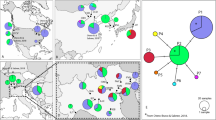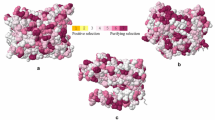Abstract
Maternally inherited symbiotic bacteria that interfere with the reproduction of their hosts can contribute to selective sweeps of mitochondrial haplotypes through hitch-hiking or coordinate inheritance of cytoplasmic bacteria and host mitochondria. The sweep will be manifested by genetic variations of mitochondrial genomic DNA of symbiont-infected hosts relative to their uninfected counterparts. In particular, at the population level, infected specimens will show a reduced mitochondrial DNA polymorphism compared to that in the nuclear DNA. This may challenge the use of mitochondrial DNA sequences as neutral genetic markers, as the mitochondrial patterns will reflect the evolutionary history of parasitism, rather than the sole evolutionary history of the host. Here, I describe a detailed step-by-step procedure to infer the occurrence and timing of symbiont-induced mitochondrial sweeps in host species.
Access this chapter
Tax calculation will be finalised at checkout
Purchases are for personal use only
Similar content being viewed by others
References
Hurst GD, Jiggins FM (2005) Problems with mitochondrial DNA as a marker in population, phylogeographic and phylogenetic studies: the effects of inherited symbionts. Proc Biol Sci 272:1525–1534
Jiggins FM, Hurst GD (2011) Microbiology. Rapid insect evolution by symbiont transfer. Science 332:185–186
Duplouy A, Hurst GD, O’Neill SL, Charlat S (2010) Rapid spread of male-killing Wolbachia in the butterfly Hypolimnas bolina. J Evol Biol 23:231–235
Engelstädter J, Hurst GD (2007) The impact of male-killing bacteria on host evolutionary processes. Genetics 175:245–254
Hurst GD, Jiggins FM, Pomiankowski A (2002) Which way to manipulate host reproduction? Wolbachia that cause cytoplasmic incompatibility are easily invaded by sex ratio-distorting mutants. Am Nat 160:360–373
Koehncke A, Telschow A, Werren JH, Hammerstein P (2009) Life and death of an influential passenger: Wolbachia and the evolution of CI-modifiers by their hosts. PLoS One 4:e4425
Correa CC, Ballard JWO (2016) Wolbachia associations with insects: winning or losing against a master manipulator. Front Ecol Evol 3:153
Hedges LM, Brownlie JC, O’Neill SL, Johnson KN (2008) Wolbachia and virus protection in insects. Science 322:702–702
Taylor MJ, Bordenstein SR, Slatko B (2018) Microbe profile: Wolbachia: a sex selector, a viral protector and a target to treat filarial nematodes. Microbiology (Reading) 164:1345–1347
Zug R, Hammerstein P (2018) Evolution of reproductive parasites with direct fitness benefits. Heredity 120:266–281
Charlat S, Duplouy A, Hornett EA, Dyson EA, Davies N, Roderick GK, Wedell N, Hurst GD (2009) The joint evolutionary histories of Wolbachia and mitochondria in Hypolimnas bolina. BMC Evol Biol 9:64
Graham RI, Wilson K (2012) Male-killing Wolbachia and mitochondrial selective sweep in a migratory African insect. BMC Evol Biol 12:204
Narita S, Nomura M, Kato Y, Fukatsu T (2006) Genetic structure of sibling butterfly species affected by Wolbachia infection sweep: evolutionary and biogeographical implications. Mol Ecol 15:1095–1108
Jiggins FM (2003) Male-killing Wolbachia and mitochondrial DNA: selective sweeps, hybrid introgression and parasite population dynamics. Genetics 164:5–12
Rodriguero MS, Lanteri AA, Confalonieri VA (2010) Mito-nuclear genetic comparison in a Wolbachia infected weevil: insights on reproductive mode, infection age and evolutionary forces shaping genetic variation. BMC Evol Biol 10:340
Jäckel R, Mora D, Dobler S (2013) Evidence for selective sweeps by Wolbachia infections: phylogeny of Altica leaf beetles and their reproductive parasites. Mol Ecol 22:4241–4255
Deng J, Assandri G, Chauchan P, Futahashi R, Galimberti A, Hansson B, Lancaster LT, Takahashi Y, Svensson EI, Duplouy A (2021) Wolbachia-driven selective sweep in a range expanding insect species. BMC Ecology and Evolution 21:181
Jiggins FM (2017) The spread of Wolbachia through mosquito populations. PLoS Biol 15:e2002780
Rokas A, Atkinson RJ, Brown GS, West SA, Stone GN (2001) Understanding patterns of genetic diversity in the oak gallwasp Biorhiza pallida: demographic history or a Wolbachia selective sweep? Heredity 87:294–304
Baldo L, Hotopp JC, Jolley KA, Bordenstein SR, Biber SA, Choudhury RR, Hayashi C, Maiden MC, Tettelin H, Werren JH (2006) Multilocus sequence typing system for the endosymbiont Wolbachia pipientis. Appl Environ Microbiol 72:7098–7110
Zhou W, Rousset F, O’Neill SL (1998) Phylogeny and PCR–based classification of Wolbachia strains using wsp gene sequences. Proceedings of the Royal Society of London. Series B: Biological Sciences 265:509–515
O’Neill SL, Giordano R, Colbert AM, Karr TL, Robertson HM (1992) 16S rRNA phylogenetic analysis of the bacterial endosymbionts associated with cytoplasmic incompatibility in insects. Proc Natl Acad Sci U S A 89:2699–2702
Simon C, Frati F, Beckenbach A, Crespi B, Liu H, Flook P (1994) Evolution, weighting, and phylogenetic utility of mitochondrial gene sequences and a compilation of conserved polymerase chain reaction primers. Ann Entomol Soc Am 87:651–701
Pietri JE, DeBruhl H, Sullivan W (2016) The rich somatic life of Wolbachia. Microbiology 5:923–936
Frost CL, Pollock SW, Smith JE, Hughes WO (2014) Wolbachia in the flesh: symbiont intensities in germ-line and somatic tissues challenge the conventional view of Wolbachia transmission routes. PLoS One 9:e95122
Barton NH (1998) The effect of hitch-hiking on neutral genealogies. Genet Res 72:123–133
Durrett R, Schweinsberg J (2004) Approximating selective sweeps. Theor Popul Biol 66:129–138
Tajima F (1989) Statistical method for testing the neutral mutation hypothesis by DNA polymorphism. Genetics 123:585–595
Fu YX, Li WH (1993) Statistical tests of neutrality of mutations. Genetics 133:693–709
Rich SM, Licht MC, Hudson RR, Ayala FJ (1998) Malaria’s eve: evidence of a recent population bottleneck throughout the world populations of Plasmodium falciparum. Proc Natl Acad Sci U S A 95:4425–4430
Ghanavi HR, Twort VG, Duplouy A (2021) Exploring bycatch diversity of organisms in whole genome sequencing of Erebidae moths (Lepidoptera). Sci Rep 11:24499
Twort VG, Minet J, Wheat CW, Wahlberg N (2021) Museomics of a rare taxon: placing Whalleyanidae in the Lepidoptera tree of life. Syst Entomol 46:926–937
Baldo L, Werren JH (2007) Revisiting Wolbachia supergroup typing based on WSP: spurious lineages and discordance with MLST. Curr Microbiol 55:81–87
Bleidorn C, Gerth M (2018) A critical re-evaluation of multilocus sequence typing (MLST) efforts in Wolbachia. FEMS Microbiol Ecol 94(1)
Booker TR, Jackson BC, Keightley PD (2017) Detecting positive selection in the genome. BMC Biol 15:98
Tuda M, Iwase SI, Kébé K, Haran J, Skuhrovec J, Sanaei E, Tsuji N, Podlussány A, Merkl O, El-Heneidy AH, Morimoto K (2021) Diversification, selective sweep, and body size in the invasive Palearctic alfalfa weevil infected with Wolbachia. Sci Rep 11:9664
Shoemaker DD, Dyer KA, Ahrens M, McAbee K, Jaenike J (2004) Decreased diversity but increased substitution rate in host mtDNA as a consequence of Wolbachia endosymbiont infection. Genetics 168:2049–2058
Miyata MN, Nomura M, Kageyama D (2020) Wolbachia have made it twice: hybrid introgression between two sister species of Eurema butterflies. Ecol Evol 10(15):323-8330
Keller GP, Windsor DM, Saucedo JM, Werren JH (2004) Reproductive effects and geographical distributions of two Wolbachia strains infecting the Neotropical beetle, Chelymorpha alternans Boh. (Chrysomelidae, Cassidinae). Mol Ecol 13:2405–2420
Kumar S, Stecher G, Li M, Knyaz C, Tamura K (2018) MEGA X: molecular evolutionary genetics analysis across computing platforms. Mol Biol Evol 35:1547–1549
Tamura K, Stecher G, Kumar S (2021) MEGA11: molecular evolutionary genetics analysis version 11. Mol Biol Evol 38:3022–3027
Acknowledgments
AD is funded by the Academy of Finland (grant #321543) and a HiLIFE fellowship. Thanks to the editor Prof. A. Fallon, as well as to Dr. P. Seppä, Dr. F. Valerio and Dr. V. Twort for comments on the manuscript.
Author information
Authors and Affiliations
Corresponding author
Editor information
Editors and Affiliations
Rights and permissions
Copyright information
© 2024 The Author(s), under exclusive license to Springer Science+Business Media, LLC, part of Springer Nature
About this protocol
Cite this protocol
Duplouy, A. (2024). Validating a Mitochondrial Sweep Accompanying the Rapid Spread of a Maternally Inherited Symbiont. In: Fallon, A.M. (eds) Wolbachia. Methods in Molecular Biology, vol 2739. Humana, New York, NY. https://doi.org/10.1007/978-1-0716-3553-7_15
Download citation
DOI: https://doi.org/10.1007/978-1-0716-3553-7_15
Published:
Publisher Name: Humana, New York, NY
Print ISBN: 978-1-0716-3552-0
Online ISBN: 978-1-0716-3553-7
eBook Packages: Springer Protocols




